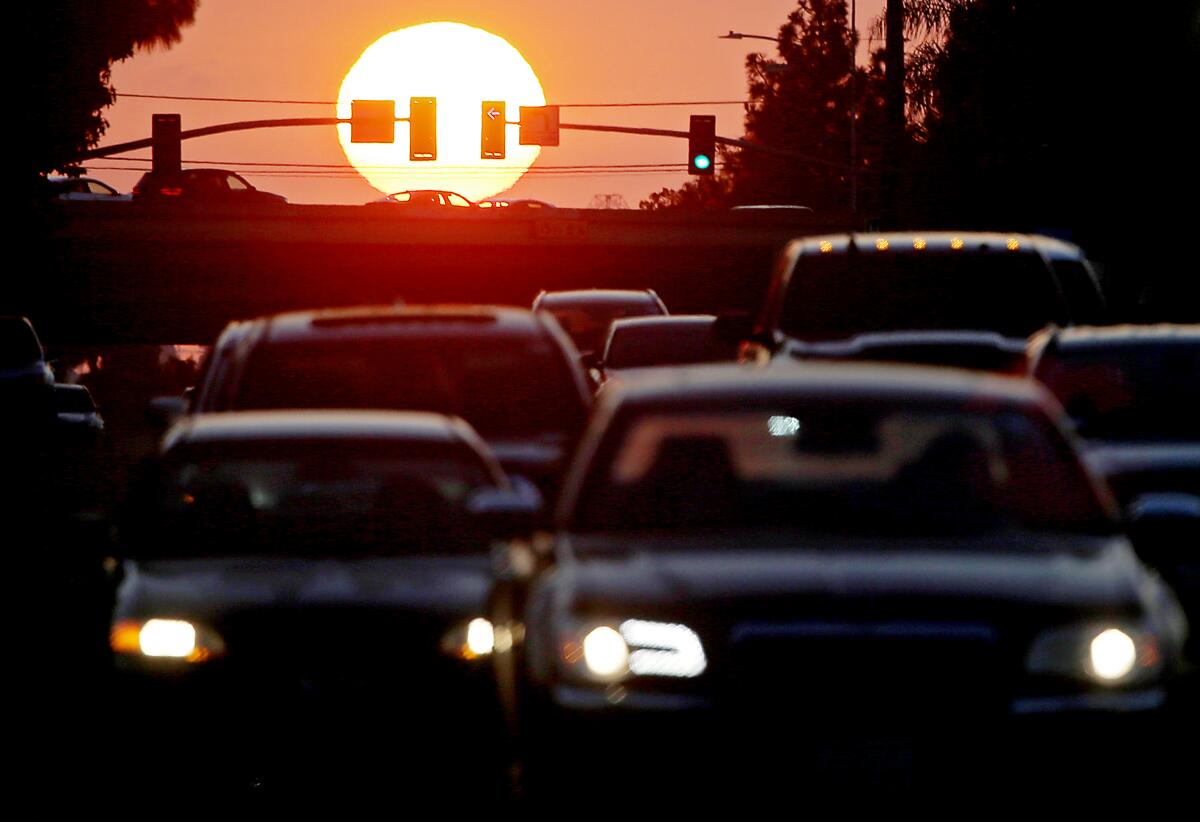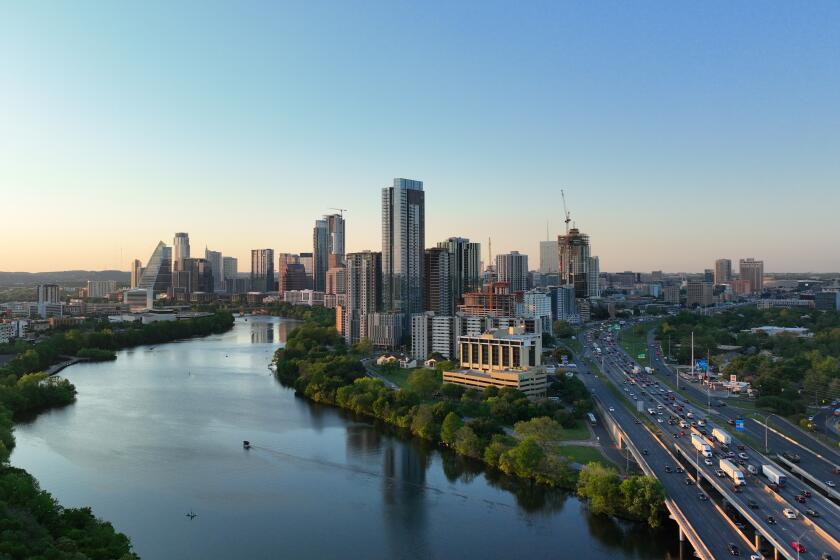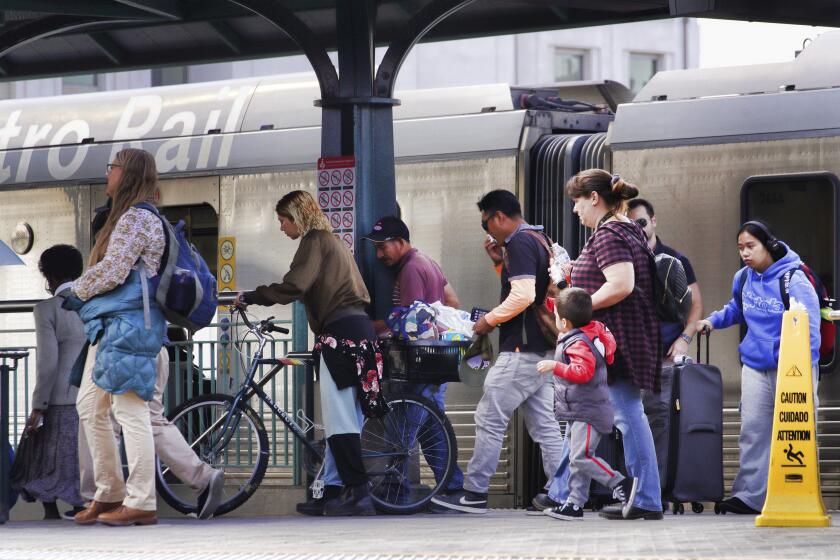SoCal housing crisis makes commute times worse. But the rich get a traffic break

Lily Parniani loves her job, but like so many Southern Californians, the 24-year-old investment analyst has to put up with a soul-sucking commute.
It can take more than two hours to get from her office in Orange County to her home 44 miles away in Riverside County.
“In total, I lose about four hours of my life every day to commuting,” she said. To make matters worse, she spends about $450 per month on automated tolls to try to make her commute more bearable.
“With the way California freeways are designed,” she said, “it basically doesn’t give you a choice but to use them.”
Long commutes are nothing new to Southern California.
But the pandemic and the region’s housing affordability crisis have worsened the pain for those who can’t afford to live in affluent job centers such as Orange County and Los Angeles’ Westside.
A Times review of census data found that about 750,000 people had commutes that cross a county border as of 2020, and that the number has steadily risen over several decades.
For the years of 2016 to 2020, census data show worsening commute times coming into Los Angeles County, especially compared with the much lighter drive from L.A. into places such as the Inland Empire and Antelope Valley.
Commute times improved during the pandemic thanks to work-from-home policies.
But Evelyn Blumenberg, an urban planning professor and director of the Lewis Center for Regional Policy Studies at UCLA, suggested the benefits have been uneven.
She noted that those who work from home are disproportionately higher-income workers.
Data from the 2022 census show that the median annual earnings of Californians who worked primarily from home was almost $80,000, compared with just under $50,000 for those who drove alone to work.
For low-income households, though, “it’s an enormous problem that we don’t have enough housing,” Blumenberg said. When people are pushed out because of high housing costs, generally “they’re not commuting back to their service-sector job in L.A.”
About 60,000 more people moved from California to Texas than the other way in 2022. Experts point to housing, taxes and politics.
Far-flung suburbs offer significantly cheaper housing than core areas of Los Angeles and Orange counties, but they have far fewer jobs. And that is what is driving the hellish commutes.
From 2016 to 2020, census data show that there were 60,000 more commuters driving from Riverside County to Orange County each day than those going in the opposite direction, a difference that has grown steadily since 2005.
In the same period, 24,000 more workers commuted daily from San Bernardino County to Orange County than those going in the opposite direction, a gap that has also grown since 2005.

Subscribers get exclusive access to this story
We’re offering L.A. Times subscribers special access to our best journalism. Thank you for your support.
Explore more Subscriber Exclusive content.
In Ventura County, 30,000 more motorists drove into Los Angeles County than the other way around from 2016 to 2020. In Riverside County, that difference was closer to 40,000 drivers, and in San Bernardino County, the difference was 70,000. There was one Southern California exception: Around 16,000 more commuters from Los Angeles County went to Orange County than the reverse.
Instead of getting behind the wheel, most so-called supercommuters — who travel more than 90 minutes to work — such as Parniani “are more likely to use transit or walk,” Blumenberg said, and those people are typically lower income.
But transit times can vary, depending on a number of factors besides distance, including congestion and mode of transport.
As a result, commute time declined from 2019 to 2021, especially for higher-income households, she said. Flexible work-from-home policies have meant that “the afternoon peak has spread out,” even on buses.
A Times review of Los Angeles County commute data from the census highlights two areas where commutes are especially long: the San Fernando Valley and South L.A.
These two areas highlight existing problems in the transportation system, Blumenberg said.
“It does not surprise me that commutes are longer” in South L.A., as residents typically live far from their workplaces and often lack serviceable public transit options.
Preliminary data — and LA’s mayor — suggest that more commuters are using public transit since a fire under the 10 Freeway closed the busy corridor.
As for the Valley, “it’s a pretty dispersed environment and it takes a long time to get to destinations,” she said.
Like the San Fernando Valley, Riverside is subject to the same forces that create long commutes: affordable homes are not located near jobs, Blumenberg said. What experts describe as suburbanization increases commute lengths and adds cars to the road as transit solutions try to keep up with sprawl.
Data for more recent years are not yet available, but Blumenberg said that the rise of remote work has been partially offset by an increase in commercial delivery vehicles such as Amazon trucks and cars used by Uber Eats.
With more flexible work schedules, peak commute times are less busy. This is at least partially offset by a higher percentage of workers choosing to commute by car than before the pandemic.
In total, congestion is less severe at peak hours but more widespread over the course of the average day, she said. “My hunch is that some of these new patterns are here to stay.”
For her part, Parniani tries to avoid commuting at the busiest times, scheduling her day around avoiding the most miserable traffic.
“Commuting was so mentally taxing,” she said, that it merited “thoroughly testing each route and documenting it to determine which one was the fastest and cheapest.” She took daily pictures of her ETAs from Google and Apple Maps, and even tested each route with her father.
For now, the office culture she enjoys is “the only thing keeping me sane with this commute.”
More to Read
Subscriber Exclusive Alert
If you're an L.A. Times subscriber, you can sign up to get alerts about early or entirely exclusive content.
You may occasionally receive promotional content from the Los Angeles Times.












